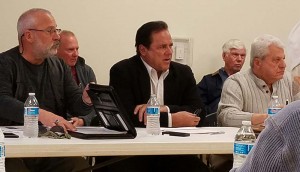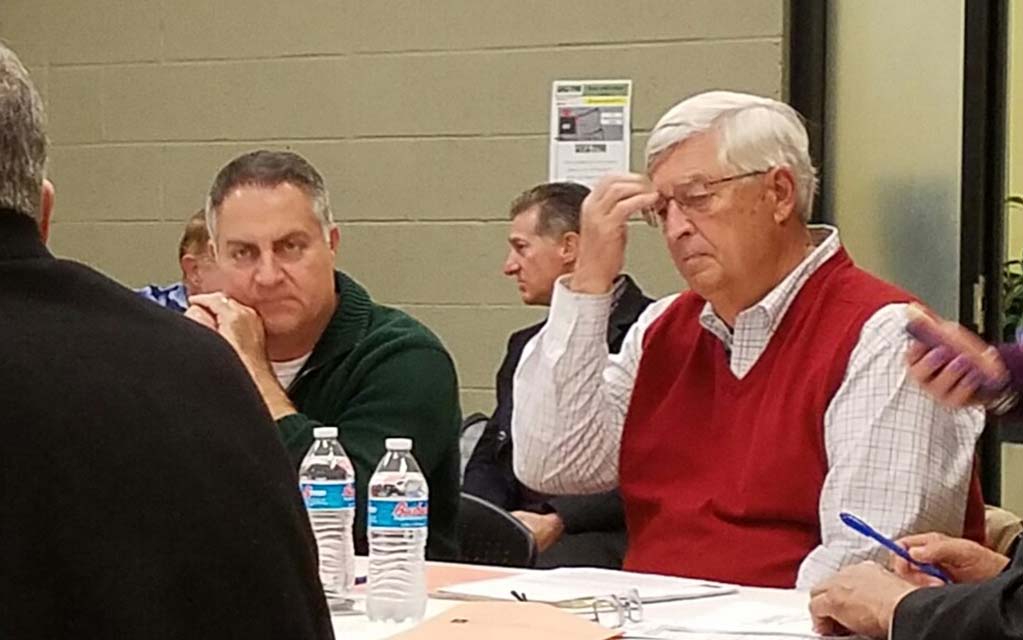CAREFREE – Town council held a special session on Tuesday, Feb. 28 to conduct a workshop to discuss the town’s short and long range financial planning along with an economic development strategy.
Mayor Les Peterson began the discussion with some facts about Carefree, stating the 8.5-square-mile town incorporated in 1984 and has a current population of approximately 3,600 with around 2,700 dwelling units.
He said the town is at about 70 percent buildout with 98 percent of its landmass (5,440 acres) zoned residential, 2 percent zoned commercial and about 80 acres of mixed use in the center of town.

Peterson said the purpose of government is to provide the “basket of services” to enhance the quality of life for its citizens.
Currently Carefree has only two sources of funding, with 56 percent coming from sales tax and the balance from state shared revenue, which is a mix of income tax and HURF (Highway User Revenue Funds) otherwise known as gas tax.
However, Peterson noted Carefree’s roads require anywhere from $800,000 to $1 million per year for maintenance while only receiving about $200,000 in HURF.
He also stated the town’s share of state revenue has been flat and is going down due to its relatively slower growth than cities such as Surprise or Mesa, for example, and the town is forecasting declines as much 20-25 percent in the future.
In every survey taken, Carefree citizens have been 90 percent against a property tax to fund town services, which cost approximately $5.8 million per year.
Peterson presented a spreadsheet showing the decline in construction sales tax from 2007 when it was $1.2 million $600,000 in 2016 and also forecasted to decline.
He said, “We’re seeing erosion in our sales tax,” which he pointed out is down 15 percent for the fiscal year to date.
Without a town property tax, Carefree homeowners typically pay $2,000 to $3,000 less than neighboring communities with a property tax.
Citizens also enjoy full fire coverage at no personal expense.
Peterson said the current financial model works well in periods of growth but cannot remain reliant on a volatile revenue stream in sales tax.
So, the goal is to come up with a way for the town to continue to deliver its “basket of services” that residents desire without having to implement a property tax, while stimulating a vital environment within the town to prevent it from “dying.”
Peterson stated that can be achieved by adding an additional $2.5 to $3 million per year to its operation revenues or reduce operating costs as an offset.
However, Peterson stated the town is already operating at as low a cost as feasible to still deliver services.
The options presented included doing nothing, which Peterson said would most likely deplete the town’s reserves in five to seven years.
Minimizing expenses was another option. Peterson said the fire contract with Rural/Metro costs $1.5 million per year. If the town eliminated its contract, property owners would have to go back to voluntary subscription service, costing the average homeowner around $1,000 per year and/or higher insurance rates.
However, if not enough people enroll, he said the town runs the risk of Rural/Metro leaving.
Because citizens are diametrically opposed to a property tax, minimizing expenses and building sales tax revenue was the most logical option, although the long term planning committee noted it did not believe the town could cut expenses sufficiently to reach its goal.
Suggestions on how to reach that goal included targeting and strengthening sales tax generators, identifying and using catalysts to encourage private investments and growth that contributes to the tax base, and further defining and emphasizing the town’s brand to cultivate and align tax generators with its identity.
Using Paradise Valley as a comparison, the targeted populations of D/C Ranch/Grayhawk, Troon North/Desert Mountain, Whisper Rock/Boulders, Carefree and Cave Creek total approximately 82,000, 24,000 households with an average household income of $151,000 and 56 percent with college degrees.
Peterson said the Paradise Valley model of high end resorts, which can each generate anywhere from $500,000 to over $1 million in tax revenue per year, also adds value to the residential community.
He said Paradise Valley generates $7-9 million per year through its resorts and restaurants.
Peterson said Carefree residents spend $62 million per year dining out of the area.
He said chef-driven restaurant concepts and brands with a “wow” factor providing unique atmosphere, impeccable service and quality food would translate into a broader appeal within the town’s market area.
Refocusing, rebranding and rezoning were suggested as a means to achieving the town’s goals and possibly rezoning four heavily traveled intersections and roadways that could bump the town’s commercial space up from 2 percent to 3.5-4 percent.
Peterson stated the town could meet its financial goals with 4 percent.
Town Administrator Gary Neiss explained what some other municipalities have done through public/private partnerships to bump up their revenue and said the most innovative and successful was Heritage Square in Gilbert, where the town purchased land in its downtown area, built buildings and leased space to businesses and restaurants and built parking structures to support its development activities.
Councilman Mike Farrar pointed out Gilbert has the opportunity to attract job growth and retail and restaurants will follow, whereas Carefree is a bedroom community.
Neiss said, “‘If you build it they will come’ has not worked,” and stated the town could optimize the four parcels per its vision instead of it being developer driven.
Councilman Gene Orrico said the town has lost 15 businesses, including three restaurants and stated everyone he’s talked to claims the town doesn’t have the demographics to support restaurants.
John Traynor said the town needs restaurants to drive the economy but the type of restaurants Carefree has are not a draw.
Peterson said rezoning the four parcels spelled out, which include Pima and Cave Creek roads, 45 acres of state land along Cave Creek Road adjacent to the airport, 10 acres at Tom Darlington Drive and Carefree Highway, and the northeast corner of Cave Creek Road and Carefree Highway would take commercial to 4.1 percent.
He said the northwest corner of Cave Creek Road and Carefree Highway is in escrow and there’s talk of a smaller supermarket and possibly a restaurant.
Peterson also stated Bashas’ was talking about the possibility of a general store concept at the intersection of Pima and Cave Creek Road.
He said the town has talked to the Boulders about the potential for a low-impact resort at the corner of Tom Darlington Drive and Carefree Highway.
Peterson said the Ed Lewis property is also in escrow and they’re talking about approximately 60 smaller units in a lower price range of $600,000 or so than Lewis’ previously proposed 42-unit project.
In conclusion, Peterson said he believes the Paradise Valley model is best suited for Carefree and once the town can attract one well-branded restaurant, others will follow.
Peterson said these were the recommendations of the Long-range Planning Committee and he didn’t know of an alternative other than a property tax.
He said the four new commercial areas can be achieved with zoning changes at no cost to the town.
Councilman Michael Krahe said the problem Carefree needs to resolve is what kind of restaurants they want and said they should have a resort-type feel.
Farrar asked if they had the political courage to rezone.
After a short break, Peterson turned the meeting over to Marketing Director Gina Kaegi to present her overall marketing strategy and goals.
Her plans included building programs and events that revitalize and re-energize the town’s image, attract a consistent flow of visitors rather than just spikes for certain events and develop a year-long program designed to attract visitors and support local businesses, while creating a point of pride for Carefree and Foothills residents.
Kaegi said the demographics the town would like to attract are “pretty much everything north of the 101,” and proposed to do more with approximately the same budget ($455,000) as last year.
Kaegi said she is fine tuning what they’ve been doing and in her third year she’s learning what works and what doesn’t.
Tapping lightly on events and festivals, comments from council members indicated road closures are problematic for residents and some businesses.
Farrar said some towns charge a facility fee for festivals that allow the town to recoup its expenses.
Peterson said they barely break even but expect to recoup about $200,000 this year.
Neiss said he hopes they have a larger cost recovery this year.
Kaegi said they want to bring residents into the fold for events and engage the community to strengthen the town’s image.
She said the town can either die or move forward and suggested having a town booth at every town event, pointing out Councilman Jim Van Allen has run the booth and finds volunteers.
Kaegi discussed extending seasonal events so it distributes people in a more desirable manner for local businesses and restaurants, stating, “It’s hard to cram 25,000 people in this space in three days,” referring to the Christmas Festival.
She said restaurants can only serve so many people in a day, so having all those people all at once leaves visitors with nowhere to go.
Another issue Kaegi called out was, even when a successful event brings people to Carefree, many of the shops are closed.
While noting Carefree is not a business, Kaegi said they do want to offset the costs and has been looking at ways to do so.
Her strategy to attract the target market with discretionary income includes putting on a high quality fall event that is unique, can continue to grow annually and generate local and national publicity.
Kaegi plans to secure existing sponsors, approach new sponsors, sign up new vendors that are compatible with the overall theme and create new activities to keep the event fresh.
She would also like to expand the Christmas Festival from a three-day event into a three-week experience to attract visitors over a longer period of time.
Although this meeting was a workshop for council to informally discuss ideas and long-term strategies, Peterson said the March 7 meeting will allow for public input.





